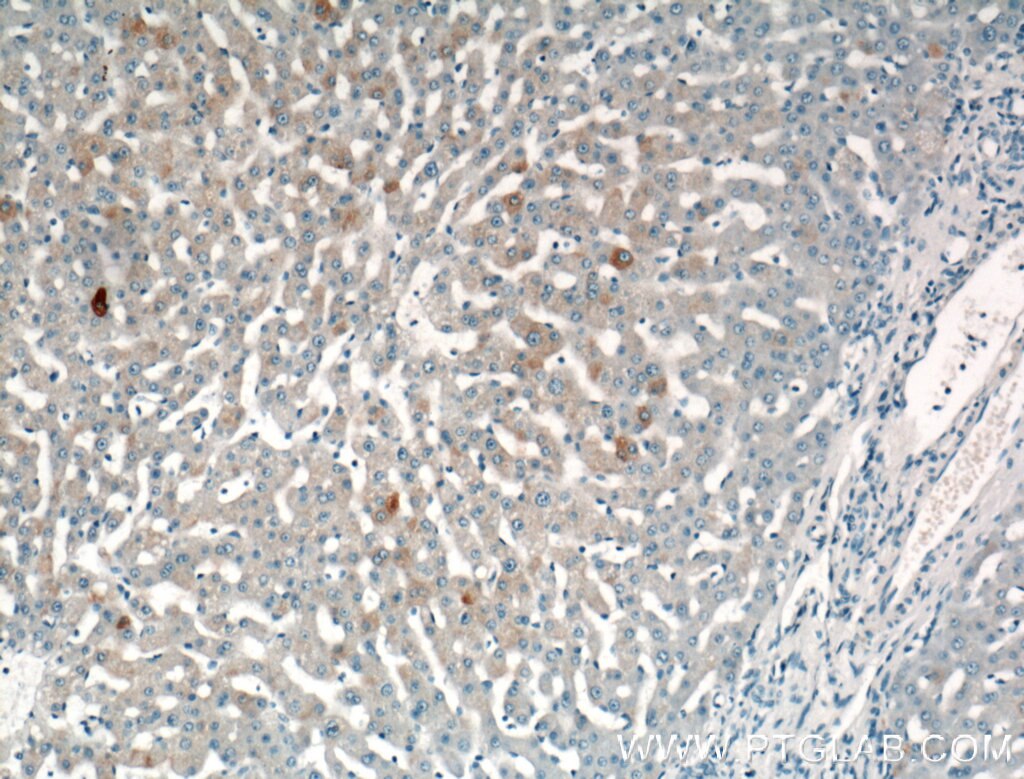- Phare
- Validé par KD/KO
Anticorps Polyclonal de lapin anti-SPG11
SPG11 Polyclonal Antibody for IHC, ELISA
Hôte / Isotype
Lapin / IgG
Réactivité testée
Humain, rat, souris
Applications
WB, IHC, CoIP, ELISA
Conjugaison
Non conjugué
N° de cat : 16555-1-AP
Synonymes
Galerie de données de validation
Applications testées
| Résultats positifs en IHC | tissu hépatique humain, il est suggéré de démasquer l'antigène avec un tampon de TE buffer pH 9.0; (*) À défaut, 'le démasquage de l'antigène peut être 'effectué avec un tampon citrate pH 6,0. |
Dilution recommandée
| Application | Dilution |
|---|---|
| Immunohistochimie (IHC) | IHC : 1:50-1:500 |
| It is recommended that this reagent should be titrated in each testing system to obtain optimal results. | |
| Sample-dependent, check data in validation data gallery | |
Applications publiées
| KD/KO | See 2 publications below |
| WB | See 8 publications below |
| CoIP | See 1 publications below |
Informations sur le produit
16555-1-AP cible SPG11 dans les applications de WB, IHC, CoIP, ELISA et montre une réactivité avec des échantillons Humain, rat, souris
| Réactivité | Humain, rat, souris |
| Réactivité citée | Humain, souris |
| Hôte / Isotype | Lapin / IgG |
| Clonalité | Polyclonal |
| Type | Anticorps |
| Immunogène | SPG11 Protéine recombinante Ag9769 |
| Nom complet | spastic paraplegia 11 (autosomal recessive) |
| Masse moléculaire calculée | 2443 aa, 279 kDa |
| Numéro d’acquisition GenBank | BC024161 |
| Symbole du gène | SPG11 |
| Identification du gène (NCBI) | 80208 |
| Conjugaison | Non conjugué |
| Forme | Liquide |
| Méthode de purification | Purification par affinité contre l'antigène |
| Tampon de stockage | PBS with 0.02% sodium azide and 50% glycerol |
| Conditions de stockage | Stocker à -20°C. Stable pendant un an après l'expédition. L'aliquotage n'est pas nécessaire pour le stockage à -20oC Les 20ul contiennent 0,1% de BSA. |
Protocole
| Product Specific Protocols | |
|---|---|
| IHC protocol for SPG11 antibody 16555-1-AP | Download protocol |
| Standard Protocols | |
|---|---|
| Click here to view our Standard Protocols |
Publications
| Species | Application | Title |
|---|---|---|
J Clin Invest Spastic paraplegia proteins spastizin and spatacsin mediate autophagic lysosome reformation. | ||
PLoS Genet A hereditary spastic paraplegia mouse model supports a role of ZFYVE26/SPASTIZIN for the endolysosomal system. | ||
Hum Mol Genet SPG15 protein deficits are at the crossroads between lysosomal abnormalities, altered lipid metabolism and synaptic dysfunction. | ||
Neurobiol Dis Loss of spatacsin function alters lysosomal lipid clearance leading to upper and lower motor neuron degeneration.
| ||
Ann Clin Transl Neurol Lysosomal abnormalities in hereditary spastic paraplegia types SPG15 and SPG11.
|



